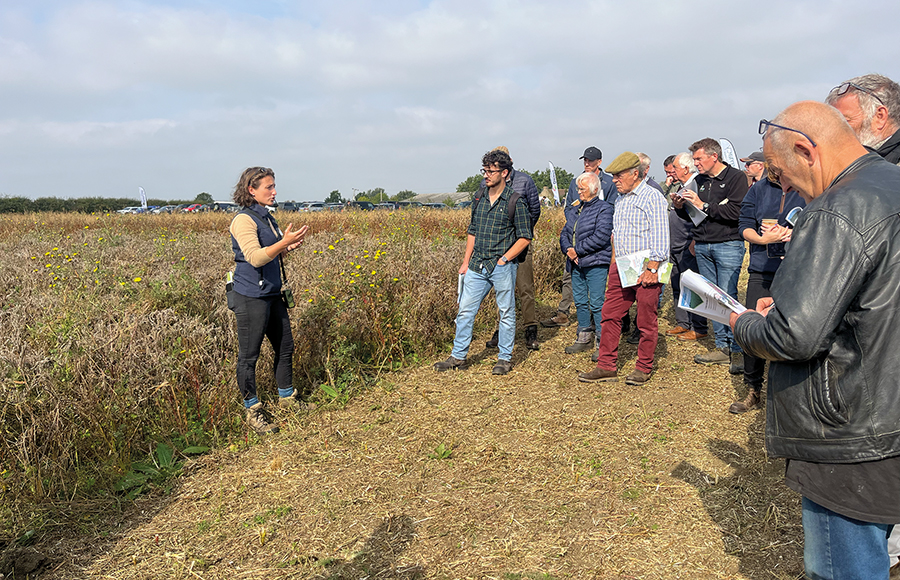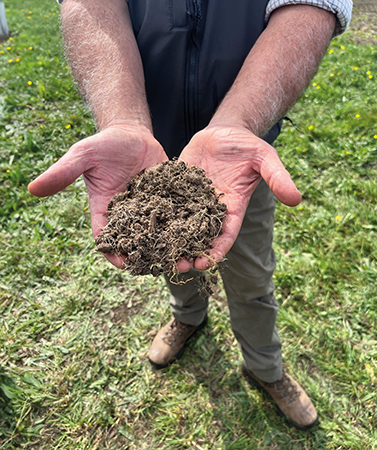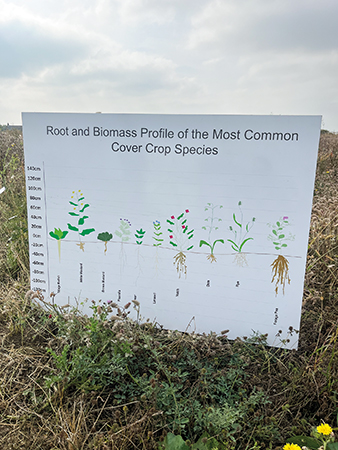Make SFI work for you
25th October 2024
In September, Hutchinsons invited growers to its annual Environmental Demonstration Day, entitled SFI: Right action, right place. Rachel Hicks was there.

Hosted by the England family in Warboys, Suffolk, the trials site is part of the Hutchinsons Helix initiative, and is dedicated to testing out environmental stewardship options which fall under the Sustainable Farming Incentive part of ELMS.
During the open day, growers could join a tour of the crop plots, in which they could learn about the different stewardship mixes, learn how to establish them successfully and discuss the benefits they deliver to biodiversity and soil health.
Getting the right benefits
Alice Cannon, agronomist and regional technical support manager, talked through selecting the right cover crop species, in order to address identified needs, and build diversity into the rotation.
She said it’s not just about getting the payment for the SFI option – it’s important to ensure your farm gets the right benefits from the cover crop, too.
Phacelia, she explained, is fantastic for pollinators. However, it can be a bit of a nightmare to manage once it sets seed – but with a challenging soil comprising Grade 1 Fenland and heavy clay-based soils on at the Warboys site, the phacelia helps to crumble the soil surface, creating a friable layer and giving better seed-to-soil ratios.
“Diversity is the absolute key when selecting covers. Cover crops won’t work 6–7 inches down – that’s for the metal to take care of. But creating that friable, structured soil near the top is where they excel,” Ms Cannon shared.
She added that turning to the spade and having a dig to see what’s going on underneath is really important for greater soil management.

“For the 2024 SFI options, phacelia works well because you need a herb, a legume, a cereal or an oilseed in a lot of the spring or summer cover crop options, compared to the 2023 options where you only needed two species for the winter cover or companion crop options,” Ms Cannon commented.
The management and termination of covers was also an important consideration when deciding what to grow, she said.
“White mustard, for example, is cheap, and can do a great job for soil structure given its deep tap root. But it does have a high carbon:nitrogen ratio, which means that if it’s not managed correctly, there can sometimes be a yield loss of 30–50% in the following spring cereal as so much nitrogen is used by the soil biology to breakdown all that carbon.
“It also wraps around the drill, so while the biomass above the ground is helpful for pollinators etc, it needs to be managed properly for the following commercial crop. It has to be sprayed off 6–8 weeks before drilling your commodity crop, or alternatively, and preferably, use it more sparingly within a wider cover crop mix.
“Every species has its pros and cons, so you need to understand those fully to deliver the benefits you want, both above and below ground. And if you’re intending to drill your cover crops beyond September, you’re seriously limiting the benefits they will bring.”
Understand and manage soil impacts

Trials at the Warboys site have highlighted one potential risk that should be considered when planning to grow a multi-year stewardship mix containing a high proportion of legumes.
The work found that the sudden release of natural nitrogen that built up in the root nodules over the course of a four-year AB15 grass-free legume fallow (containing vetch, clover, sainfoin, lucerne and others) acted as a “super food” for soil biology, prompting a spike in the consumption of organic matter, that in turn, caused soil aggregates to collapse.
“Soil aggregates form around organic matter, so when that is consumed, the structure collapses, causing the soil to become tight,” Hutchinsons technical manager, Dick Neale, explained. “The soil’s not compacted, and is still in good condition, full of roots, with decent infiltration, but it does need to be managed carefully to open that structure back up.”
A comparison of a multi-species MaxiCover mix versus just wheat grown in plastic grow tubes neatly illustrates this. The mix of root architecture and depths in the MaxiCover mix leaves a stable, moist, friable soil, whereas the wheat is a dense mat of roots.
“It’s still good rooting and soil aggregation, but with such a thick mat of root, it could be tricky to drill into and achieve good seed-to-soil contact, especially when you consider a disc drill travelling at 10kph has around seven hundredths of a second to cut a slot, place a seed, and cover it over with the press wheel,” explained Mr Neale.
Combining commodities with cover crops
Charles Parkinson farms on brashy soil in Stamford, Lincolnshire. The rotation of wheat, barley, winter oats, winter beans and winter OSR is joined by rotational land in the NUM3 legume fallow under SFI, as well as 60ha of unproductive land under wild bird cover mixes. A total of around 10% of the farm is guaranteed an income under SFI, but Charles has stacked yield maps to work out the productivity and profitability of each area in order to get the best out of his land.
“We also undertake companion cropping, with berseem clover and buckwheat alongside OSR, for pest control and soil health. Where it’s profitable to grow commodity crops we do, but where it’s not we can guarantee an income for that land under SFI,” commented Charles.
Read more arable news
